Analyzing Depression in Women: A Research Portfolio, ASS081-2 Unit
VerifiedAdded on 2023/01/11
|13
|4010
|67
Portfolio
AI Summary
This research portfolio examines the multifaceted issue of depression in women. It begins with an introduction highlighting the significance of understanding depression's impact on women and the importance of providing support. The portfolio includes a comprehensive literature review, analyzing various perspectives on depression, its causes, and its effects on women's lives, referencing key research and viewpoints from various authors. Data analysis is performed, presenting statistical data on the prevalence of depression among women, demographic insights, and trends over time. The portfolio further explores media representation of depression and relevant policies, laws, and legislations. It concludes with a reflection statement, a proposed research question, outlining research methods, ethical considerations, and data analysis techniques, providing a comprehensive overview of depression in women and strategies to support them.
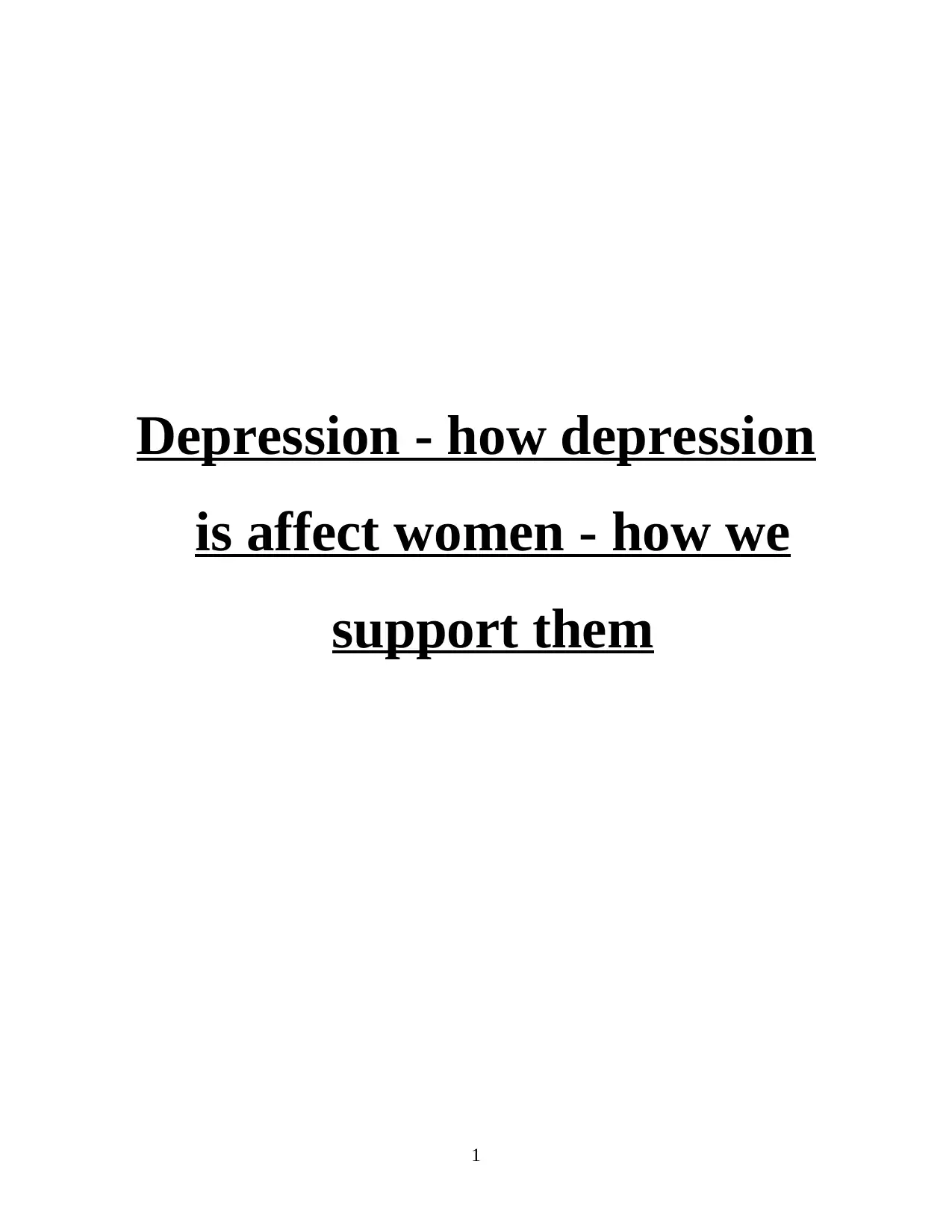
Depression - how depression
is affect women - how we
support them
1
is affect women - how we
support them
1
Paraphrase This Document
Need a fresh take? Get an instant paraphrase of this document with our AI Paraphraser
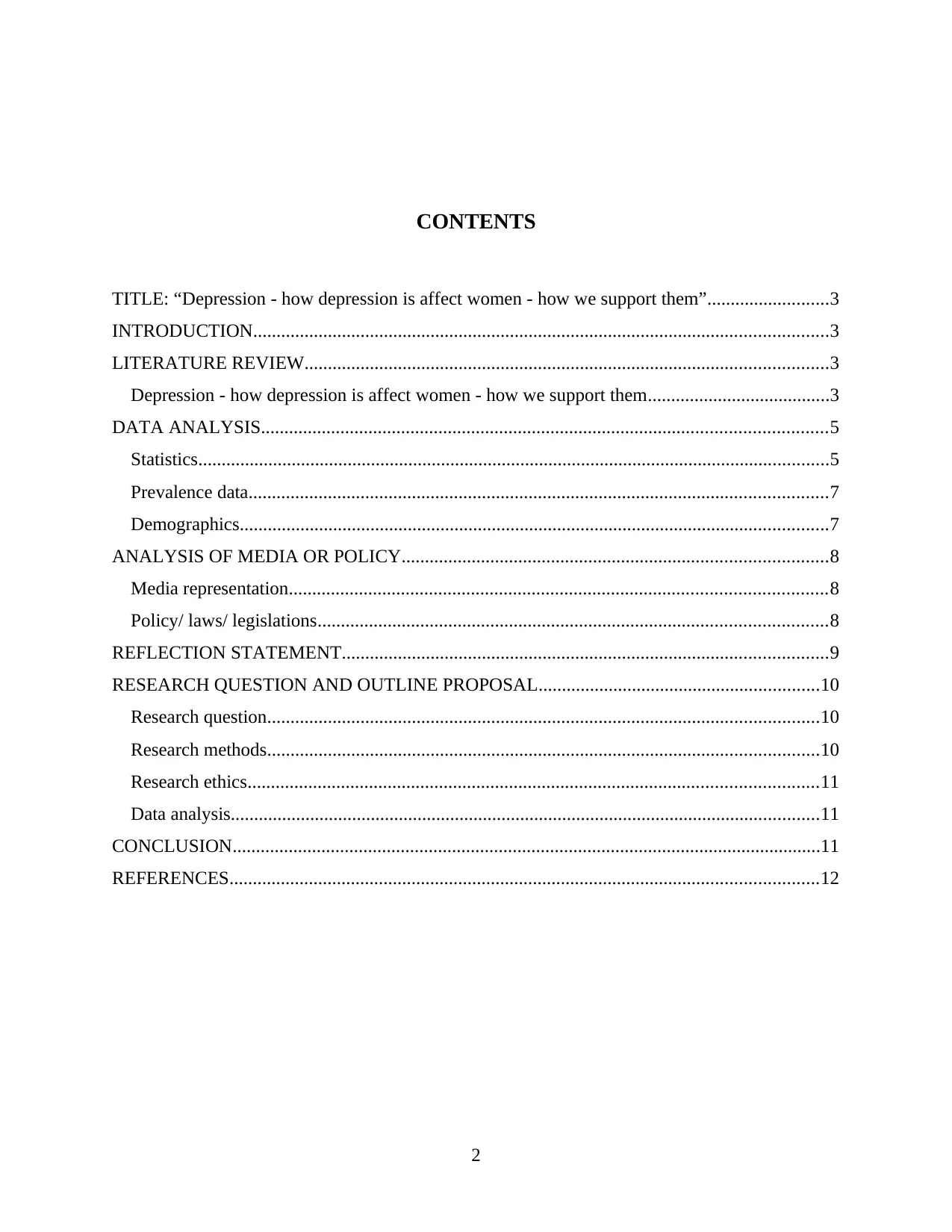
CONTENTS
TITLE: “Depression - how depression is affect women - how we support them”..........................3
INTRODUCTION...........................................................................................................................3
LITERATURE REVIEW................................................................................................................3
Depression - how depression is affect women - how we support them.......................................3
DATA ANALYSIS.........................................................................................................................5
Statistics.......................................................................................................................................5
Prevalence data............................................................................................................................7
Demographics..............................................................................................................................7
ANALYSIS OF MEDIA OR POLICY...........................................................................................8
Media representation...................................................................................................................8
Policy/ laws/ legislations.............................................................................................................8
REFLECTION STATEMENT........................................................................................................9
RESEARCH QUESTION AND OUTLINE PROPOSAL............................................................10
Research question......................................................................................................................10
Research methods......................................................................................................................10
Research ethics..........................................................................................................................11
Data analysis..............................................................................................................................11
CONCLUSION..............................................................................................................................11
REFERENCES..............................................................................................................................12
2
TITLE: “Depression - how depression is affect women - how we support them”..........................3
INTRODUCTION...........................................................................................................................3
LITERATURE REVIEW................................................................................................................3
Depression - how depression is affect women - how we support them.......................................3
DATA ANALYSIS.........................................................................................................................5
Statistics.......................................................................................................................................5
Prevalence data............................................................................................................................7
Demographics..............................................................................................................................7
ANALYSIS OF MEDIA OR POLICY...........................................................................................8
Media representation...................................................................................................................8
Policy/ laws/ legislations.............................................................................................................8
REFLECTION STATEMENT........................................................................................................9
RESEARCH QUESTION AND OUTLINE PROPOSAL............................................................10
Research question......................................................................................................................10
Research methods......................................................................................................................10
Research ethics..........................................................................................................................11
Data analysis..............................................................................................................................11
CONCLUSION..............................................................................................................................11
REFERENCES..............................................................................................................................12
2
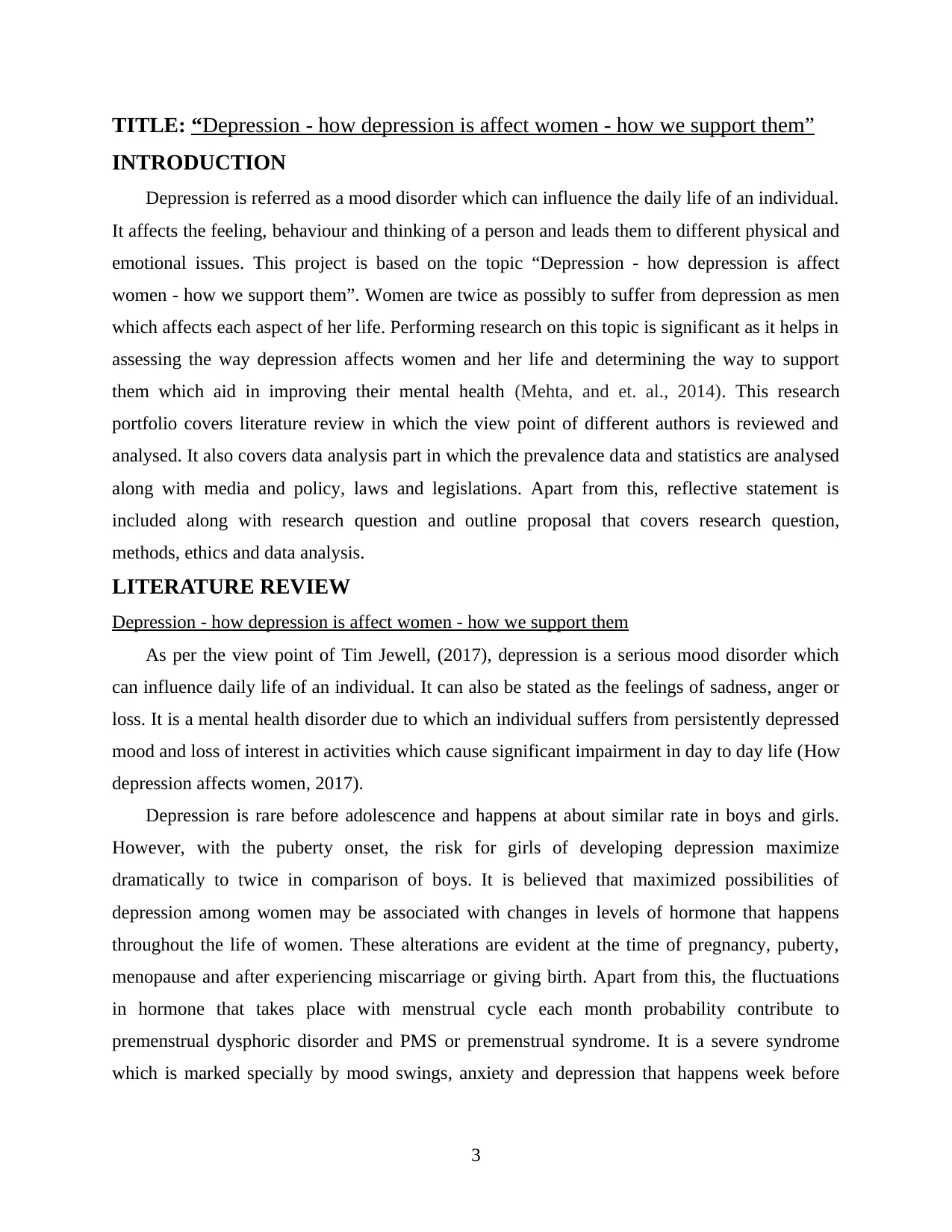
TITLE: “Depression - how depression is affect women - how we support them”
INTRODUCTION
Depression is referred as a mood disorder which can influence the daily life of an individual.
It affects the feeling, behaviour and thinking of a person and leads them to different physical and
emotional issues. This project is based on the topic “Depression - how depression is affect
women - how we support them”. Women are twice as possibly to suffer from depression as men
which affects each aspect of her life. Performing research on this topic is significant as it helps in
assessing the way depression affects women and her life and determining the way to support
them which aid in improving their mental health (Mehta, and et. al., 2014). This research
portfolio covers literature review in which the view point of different authors is reviewed and
analysed. It also covers data analysis part in which the prevalence data and statistics are analysed
along with media and policy, laws and legislations. Apart from this, reflective statement is
included along with research question and outline proposal that covers research question,
methods, ethics and data analysis.
LITERATURE REVIEW
Depression - how depression is affect women - how we support them
As per the view point of Tim Jewell, (2017), depression is a serious mood disorder which
can influence daily life of an individual. It can also be stated as the feelings of sadness, anger or
loss. It is a mental health disorder due to which an individual suffers from persistently depressed
mood and loss of interest in activities which cause significant impairment in day to day life (How
depression affects women, 2017).
Depression is rare before adolescence and happens at about similar rate in boys and girls.
However, with the puberty onset, the risk for girls of developing depression maximize
dramatically to twice in comparison of boys. It is believed that maximized possibilities of
depression among women may be associated with changes in levels of hormone that happens
throughout the life of women. These alterations are evident at the time of pregnancy, puberty,
menopause and after experiencing miscarriage or giving birth. Apart from this, the fluctuations
in hormone that takes place with menstrual cycle each month probability contribute to
premenstrual dysphoric disorder and PMS or premenstrual syndrome. It is a severe syndrome
which is marked specially by mood swings, anxiety and depression that happens week before
3
INTRODUCTION
Depression is referred as a mood disorder which can influence the daily life of an individual.
It affects the feeling, behaviour and thinking of a person and leads them to different physical and
emotional issues. This project is based on the topic “Depression - how depression is affect
women - how we support them”. Women are twice as possibly to suffer from depression as men
which affects each aspect of her life. Performing research on this topic is significant as it helps in
assessing the way depression affects women and her life and determining the way to support
them which aid in improving their mental health (Mehta, and et. al., 2014). This research
portfolio covers literature review in which the view point of different authors is reviewed and
analysed. It also covers data analysis part in which the prevalence data and statistics are analysed
along with media and policy, laws and legislations. Apart from this, reflective statement is
included along with research question and outline proposal that covers research question,
methods, ethics and data analysis.
LITERATURE REVIEW
Depression - how depression is affect women - how we support them
As per the view point of Tim Jewell, (2017), depression is a serious mood disorder which
can influence daily life of an individual. It can also be stated as the feelings of sadness, anger or
loss. It is a mental health disorder due to which an individual suffers from persistently depressed
mood and loss of interest in activities which cause significant impairment in day to day life (How
depression affects women, 2017).
Depression is rare before adolescence and happens at about similar rate in boys and girls.
However, with the puberty onset, the risk for girls of developing depression maximize
dramatically to twice in comparison of boys. It is believed that maximized possibilities of
depression among women may be associated with changes in levels of hormone that happens
throughout the life of women. These alterations are evident at the time of pregnancy, puberty,
menopause and after experiencing miscarriage or giving birth. Apart from this, the fluctuations
in hormone that takes place with menstrual cycle each month probability contribute to
premenstrual dysphoric disorder and PMS or premenstrual syndrome. It is a severe syndrome
which is marked specially by mood swings, anxiety and depression that happens week before
3
⊘ This is a preview!⊘
Do you want full access?
Subscribe today to unlock all pages.

Trusted by 1+ million students worldwide
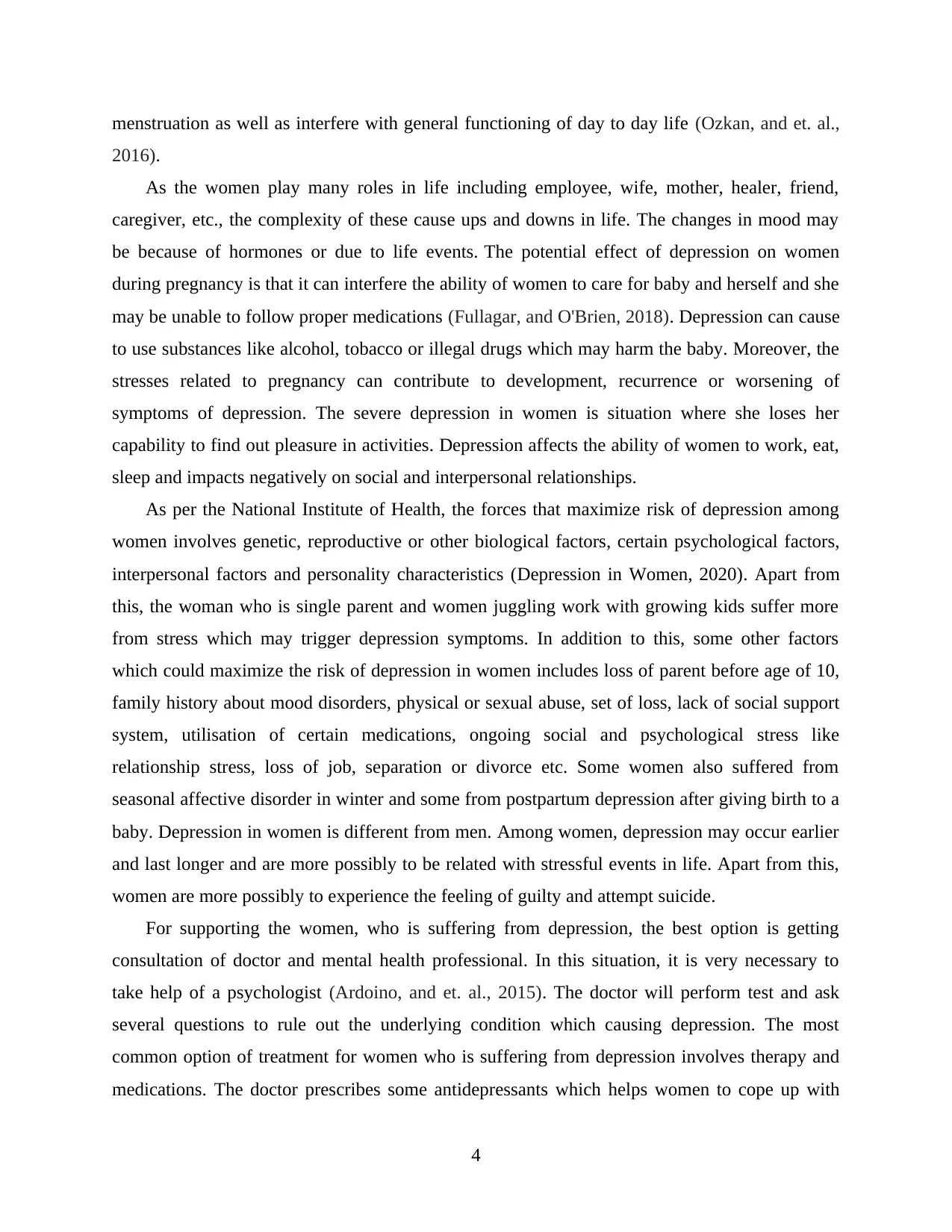
menstruation as well as interfere with general functioning of day to day life (Ozkan, and et. al.,
2016).
As the women play many roles in life including employee, wife, mother, healer, friend,
caregiver, etc., the complexity of these cause ups and downs in life. The changes in mood may
be because of hormones or due to life events. The potential effect of depression on women
during pregnancy is that it can interfere the ability of women to care for baby and herself and she
may be unable to follow proper medications (Fullagar, and O'Brien, 2018). Depression can cause
to use substances like alcohol, tobacco or illegal drugs which may harm the baby. Moreover, the
stresses related to pregnancy can contribute to development, recurrence or worsening of
symptoms of depression. The severe depression in women is situation where she loses her
capability to find out pleasure in activities. Depression affects the ability of women to work, eat,
sleep and impacts negatively on social and interpersonal relationships.
As per the National Institute of Health, the forces that maximize risk of depression among
women involves genetic, reproductive or other biological factors, certain psychological factors,
interpersonal factors and personality characteristics (Depression in Women, 2020). Apart from
this, the woman who is single parent and women juggling work with growing kids suffer more
from stress which may trigger depression symptoms. In addition to this, some other factors
which could maximize the risk of depression in women includes loss of parent before age of 10,
family history about mood disorders, physical or sexual abuse, set of loss, lack of social support
system, utilisation of certain medications, ongoing social and psychological stress like
relationship stress, loss of job, separation or divorce etc. Some women also suffered from
seasonal affective disorder in winter and some from postpartum depression after giving birth to a
baby. Depression in women is different from men. Among women, depression may occur earlier
and last longer and are more possibly to be related with stressful events in life. Apart from this,
women are more possibly to experience the feeling of guilty and attempt suicide.
For supporting the women, who is suffering from depression, the best option is getting
consultation of doctor and mental health professional. In this situation, it is very necessary to
take help of a psychologist (Ardoino, and et. al., 2015). The doctor will perform test and ask
several questions to rule out the underlying condition which causing depression. The most
common option of treatment for women who is suffering from depression involves therapy and
medications. The doctor prescribes some antidepressants which helps women to cope up with
4
2016).
As the women play many roles in life including employee, wife, mother, healer, friend,
caregiver, etc., the complexity of these cause ups and downs in life. The changes in mood may
be because of hormones or due to life events. The potential effect of depression on women
during pregnancy is that it can interfere the ability of women to care for baby and herself and she
may be unable to follow proper medications (Fullagar, and O'Brien, 2018). Depression can cause
to use substances like alcohol, tobacco or illegal drugs which may harm the baby. Moreover, the
stresses related to pregnancy can contribute to development, recurrence or worsening of
symptoms of depression. The severe depression in women is situation where she loses her
capability to find out pleasure in activities. Depression affects the ability of women to work, eat,
sleep and impacts negatively on social and interpersonal relationships.
As per the National Institute of Health, the forces that maximize risk of depression among
women involves genetic, reproductive or other biological factors, certain psychological factors,
interpersonal factors and personality characteristics (Depression in Women, 2020). Apart from
this, the woman who is single parent and women juggling work with growing kids suffer more
from stress which may trigger depression symptoms. In addition to this, some other factors
which could maximize the risk of depression in women includes loss of parent before age of 10,
family history about mood disorders, physical or sexual abuse, set of loss, lack of social support
system, utilisation of certain medications, ongoing social and psychological stress like
relationship stress, loss of job, separation or divorce etc. Some women also suffered from
seasonal affective disorder in winter and some from postpartum depression after giving birth to a
baby. Depression in women is different from men. Among women, depression may occur earlier
and last longer and are more possibly to be related with stressful events in life. Apart from this,
women are more possibly to experience the feeling of guilty and attempt suicide.
For supporting the women, who is suffering from depression, the best option is getting
consultation of doctor and mental health professional. In this situation, it is very necessary to
take help of a psychologist (Ardoino, and et. al., 2015). The doctor will perform test and ask
several questions to rule out the underlying condition which causing depression. The most
common option of treatment for women who is suffering from depression involves therapy and
medications. The doctor prescribes some antidepressants which helps women to cope up with
4
Paraphrase This Document
Need a fresh take? Get an instant paraphrase of this document with our AI Paraphraser
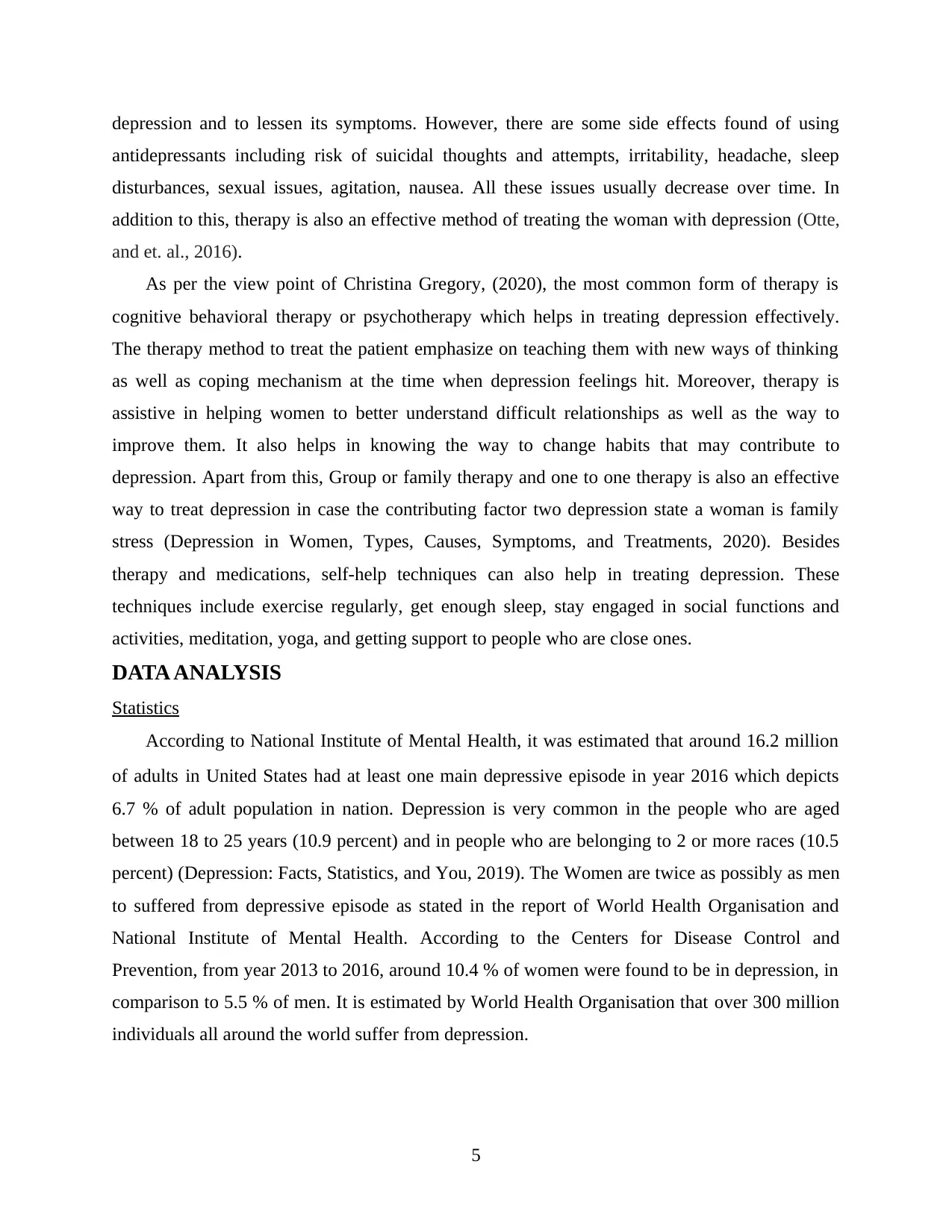
depression and to lessen its symptoms. However, there are some side effects found of using
antidepressants including risk of suicidal thoughts and attempts, irritability, headache, sleep
disturbances, sexual issues, agitation, nausea. All these issues usually decrease over time. In
addition to this, therapy is also an effective method of treating the woman with depression (Otte,
and et. al., 2016).
As per the view point of Christina Gregory, (2020), the most common form of therapy is
cognitive behavioral therapy or psychotherapy which helps in treating depression effectively.
The therapy method to treat the patient emphasize on teaching them with new ways of thinking
as well as coping mechanism at the time when depression feelings hit. Moreover, therapy is
assistive in helping women to better understand difficult relationships as well as the way to
improve them. It also helps in knowing the way to change habits that may contribute to
depression. Apart from this, Group or family therapy and one to one therapy is also an effective
way to treat depression in case the contributing factor two depression state a woman is family
stress (Depression in Women, Types, Causes, Symptoms, and Treatments, 2020). Besides
therapy and medications, self-help techniques can also help in treating depression. These
techniques include exercise regularly, get enough sleep, stay engaged in social functions and
activities, meditation, yoga, and getting support to people who are close ones.
DATA ANALYSIS
Statistics
According to National Institute of Mental Health, it was estimated that around 16.2 million
of adults in United States had at least one main depressive episode in year 2016 which depicts
6.7 % of adult population in nation. Depression is very common in the people who are aged
between 18 to 25 years (10.9 percent) and in people who are belonging to 2 or more races (10.5
percent) (Depression: Facts, Statistics, and You, 2019). The Women are twice as possibly as men
to suffered from depressive episode as stated in the report of World Health Organisation and
National Institute of Mental Health. According to the Centers for Disease Control and
Prevention, from year 2013 to 2016, around 10.4 % of women were found to be in depression, in
comparison to 5.5 % of men. It is estimated by World Health Organisation that over 300 million
individuals all around the world suffer from depression.
5
antidepressants including risk of suicidal thoughts and attempts, irritability, headache, sleep
disturbances, sexual issues, agitation, nausea. All these issues usually decrease over time. In
addition to this, therapy is also an effective method of treating the woman with depression (Otte,
and et. al., 2016).
As per the view point of Christina Gregory, (2020), the most common form of therapy is
cognitive behavioral therapy or psychotherapy which helps in treating depression effectively.
The therapy method to treat the patient emphasize on teaching them with new ways of thinking
as well as coping mechanism at the time when depression feelings hit. Moreover, therapy is
assistive in helping women to better understand difficult relationships as well as the way to
improve them. It also helps in knowing the way to change habits that may contribute to
depression. Apart from this, Group or family therapy and one to one therapy is also an effective
way to treat depression in case the contributing factor two depression state a woman is family
stress (Depression in Women, Types, Causes, Symptoms, and Treatments, 2020). Besides
therapy and medications, self-help techniques can also help in treating depression. These
techniques include exercise regularly, get enough sleep, stay engaged in social functions and
activities, meditation, yoga, and getting support to people who are close ones.
DATA ANALYSIS
Statistics
According to National Institute of Mental Health, it was estimated that around 16.2 million
of adults in United States had at least one main depressive episode in year 2016 which depicts
6.7 % of adult population in nation. Depression is very common in the people who are aged
between 18 to 25 years (10.9 percent) and in people who are belonging to 2 or more races (10.5
percent) (Depression: Facts, Statistics, and You, 2019). The Women are twice as possibly as men
to suffered from depressive episode as stated in the report of World Health Organisation and
National Institute of Mental Health. According to the Centers for Disease Control and
Prevention, from year 2013 to 2016, around 10.4 % of women were found to be in depression, in
comparison to 5.5 % of men. It is estimated by World Health Organisation that over 300 million
individuals all around the world suffer from depression.
5
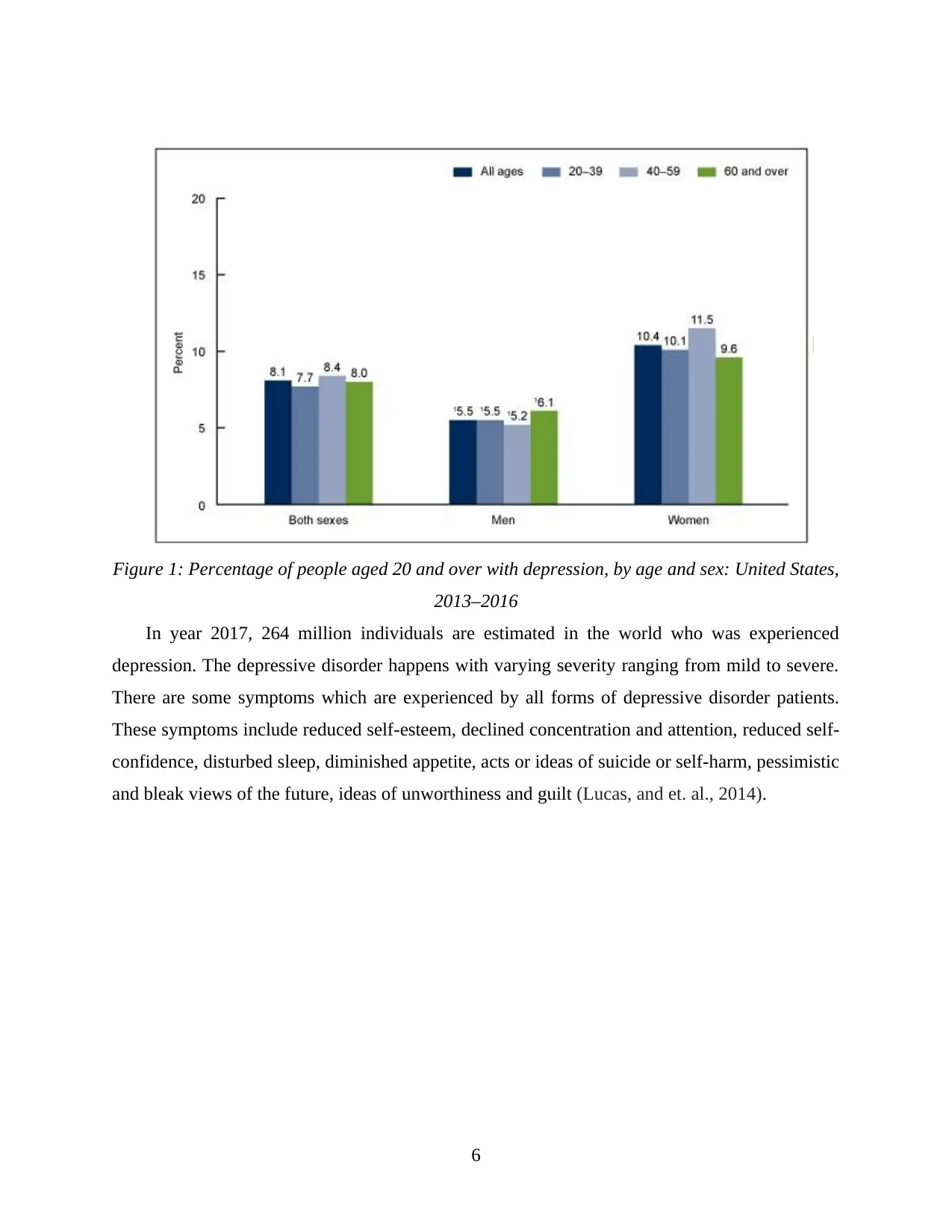
Figure 1: Percentage of people aged 20 and over with depression, by age and sex: United States,
2013–2016
In year 2017, 264 million individuals are estimated in the world who was experienced
depression. The depressive disorder happens with varying severity ranging from mild to severe.
There are some symptoms which are experienced by all forms of depressive disorder patients.
These symptoms include reduced self-esteem, declined concentration and attention, reduced self-
confidence, disturbed sleep, diminished appetite, acts or ideas of suicide or self-harm, pessimistic
and bleak views of the future, ideas of unworthiness and guilt (Lucas, and et. al., 2014).
6
2013–2016
In year 2017, 264 million individuals are estimated in the world who was experienced
depression. The depressive disorder happens with varying severity ranging from mild to severe.
There are some symptoms which are experienced by all forms of depressive disorder patients.
These symptoms include reduced self-esteem, declined concentration and attention, reduced self-
confidence, disturbed sleep, diminished appetite, acts or ideas of suicide or self-harm, pessimistic
and bleak views of the future, ideas of unworthiness and guilt (Lucas, and et. al., 2014).
6
⊘ This is a preview!⊘
Do you want full access?
Subscribe today to unlock all pages.

Trusted by 1+ million students worldwide
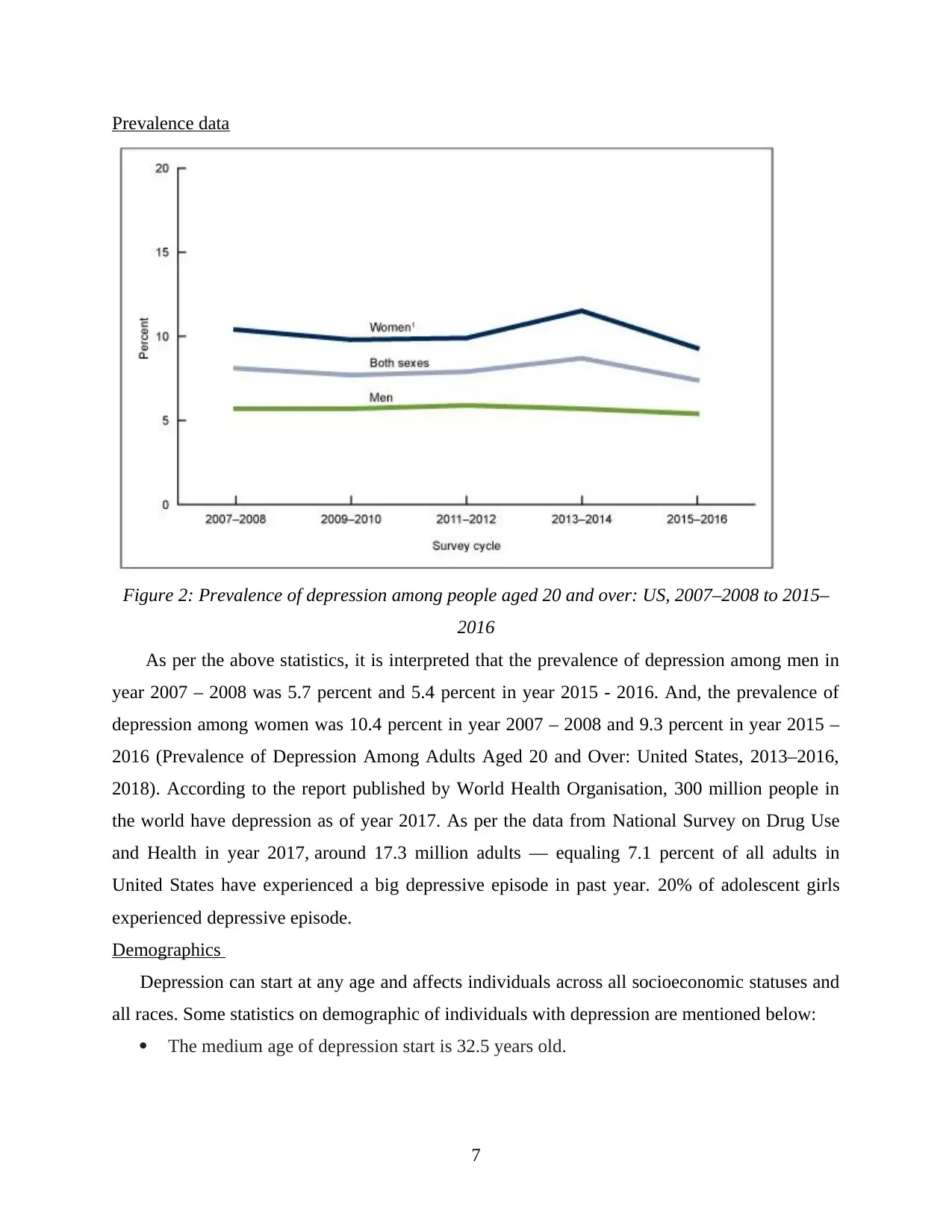
Prevalence data
Figure 2: Prevalence of depression among people aged 20 and over: US, 2007–2008 to 2015–
2016
As per the above statistics, it is interpreted that the prevalence of depression among men in
year 2007 – 2008 was 5.7 percent and 5.4 percent in year 2015 - 2016. And, the prevalence of
depression among women was 10.4 percent in year 2007 – 2008 and 9.3 percent in year 2015 –
2016 (Prevalence of Depression Among Adults Aged 20 and Over: United States, 2013–2016,
2018). According to the report published by World Health Organisation, 300 million people in
the world have depression as of year 2017. As per the data from National Survey on Drug Use
and Health in year 2017, around 17.3 million adults — equaling 7.1 percent of all adults in
United States have experienced a big depressive episode in past year. 20% of adolescent girls
experienced depressive episode.
Demographics
Depression can start at any age and affects individuals across all socioeconomic statuses and
all races. Some statistics on demographic of individuals with depression are mentioned below:
The medium age of depression start is 32.5 years old.
7
Figure 2: Prevalence of depression among people aged 20 and over: US, 2007–2008 to 2015–
2016
As per the above statistics, it is interpreted that the prevalence of depression among men in
year 2007 – 2008 was 5.7 percent and 5.4 percent in year 2015 - 2016. And, the prevalence of
depression among women was 10.4 percent in year 2007 – 2008 and 9.3 percent in year 2015 –
2016 (Prevalence of Depression Among Adults Aged 20 and Over: United States, 2013–2016,
2018). According to the report published by World Health Organisation, 300 million people in
the world have depression as of year 2017. As per the data from National Survey on Drug Use
and Health in year 2017, around 17.3 million adults — equaling 7.1 percent of all adults in
United States have experienced a big depressive episode in past year. 20% of adolescent girls
experienced depressive episode.
Demographics
Depression can start at any age and affects individuals across all socioeconomic statuses and
all races. Some statistics on demographic of individuals with depression are mentioned below:
The medium age of depression start is 32.5 years old.
7
Paraphrase This Document
Need a fresh take? Get an instant paraphrase of this document with our AI Paraphraser
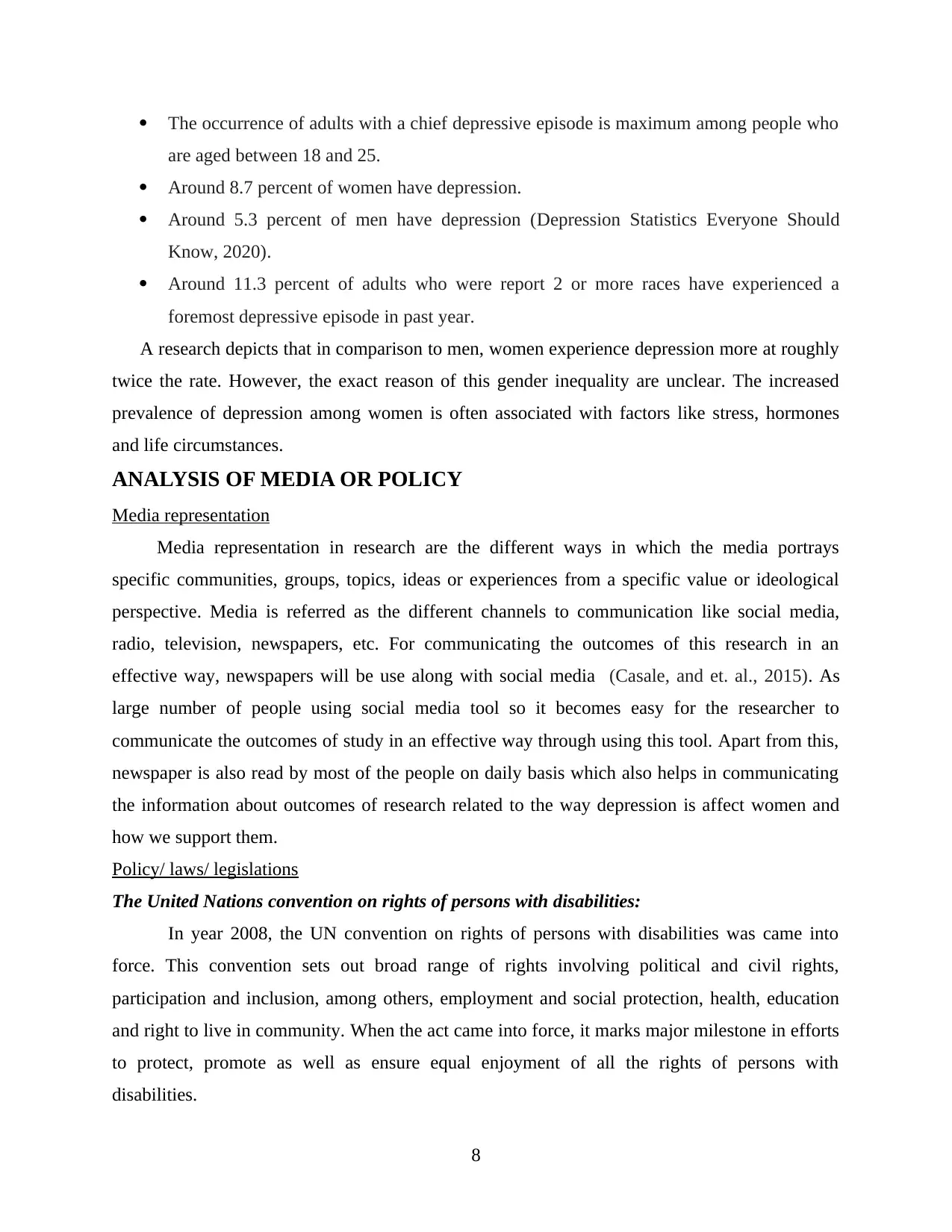
The occurrence of adults with a chief depressive episode is maximum among people who
are aged between 18 and 25.
Around 8.7 percent of women have depression.
Around 5.3 percent of men have depression (Depression Statistics Everyone Should
Know, 2020).
Around 11.3 percent of adults who were report 2 or more races have experienced a
foremost depressive episode in past year.
A research depicts that in comparison to men, women experience depression more at roughly
twice the rate. However, the exact reason of this gender inequality are unclear. The increased
prevalence of depression among women is often associated with factors like stress, hormones
and life circumstances.
ANALYSIS OF MEDIA OR POLICY
Media representation
Media representation in research are the different ways in which the media portrays
specific communities, groups, topics, ideas or experiences from a specific value or ideological
perspective. Media is referred as the different channels to communication like social media,
radio, television, newspapers, etc. For communicating the outcomes of this research in an
effective way, newspapers will be use along with social media (Casale, and et. al., 2015). As
large number of people using social media tool so it becomes easy for the researcher to
communicate the outcomes of study in an effective way through using this tool. Apart from this,
newspaper is also read by most of the people on daily basis which also helps in communicating
the information about outcomes of research related to the way depression is affect women and
how we support them.
Policy/ laws/ legislations
The United Nations convention on rights of persons with disabilities:
In year 2008, the UN convention on rights of persons with disabilities was came into
force. This convention sets out broad range of rights involving political and civil rights,
participation and inclusion, among others, employment and social protection, health, education
and right to live in community. When the act came into force, it marks major milestone in efforts
to protect, promote as well as ensure equal enjoyment of all the rights of persons with
disabilities.
8
are aged between 18 and 25.
Around 8.7 percent of women have depression.
Around 5.3 percent of men have depression (Depression Statistics Everyone Should
Know, 2020).
Around 11.3 percent of adults who were report 2 or more races have experienced a
foremost depressive episode in past year.
A research depicts that in comparison to men, women experience depression more at roughly
twice the rate. However, the exact reason of this gender inequality are unclear. The increased
prevalence of depression among women is often associated with factors like stress, hormones
and life circumstances.
ANALYSIS OF MEDIA OR POLICY
Media representation
Media representation in research are the different ways in which the media portrays
specific communities, groups, topics, ideas or experiences from a specific value or ideological
perspective. Media is referred as the different channels to communication like social media,
radio, television, newspapers, etc. For communicating the outcomes of this research in an
effective way, newspapers will be use along with social media (Casale, and et. al., 2015). As
large number of people using social media tool so it becomes easy for the researcher to
communicate the outcomes of study in an effective way through using this tool. Apart from this,
newspaper is also read by most of the people on daily basis which also helps in communicating
the information about outcomes of research related to the way depression is affect women and
how we support them.
Policy/ laws/ legislations
The United Nations convention on rights of persons with disabilities:
In year 2008, the UN convention on rights of persons with disabilities was came into
force. This convention sets out broad range of rights involving political and civil rights,
participation and inclusion, among others, employment and social protection, health, education
and right to live in community. When the act came into force, it marks major milestone in efforts
to protect, promote as well as ensure equal enjoyment of all the rights of persons with
disabilities.
8
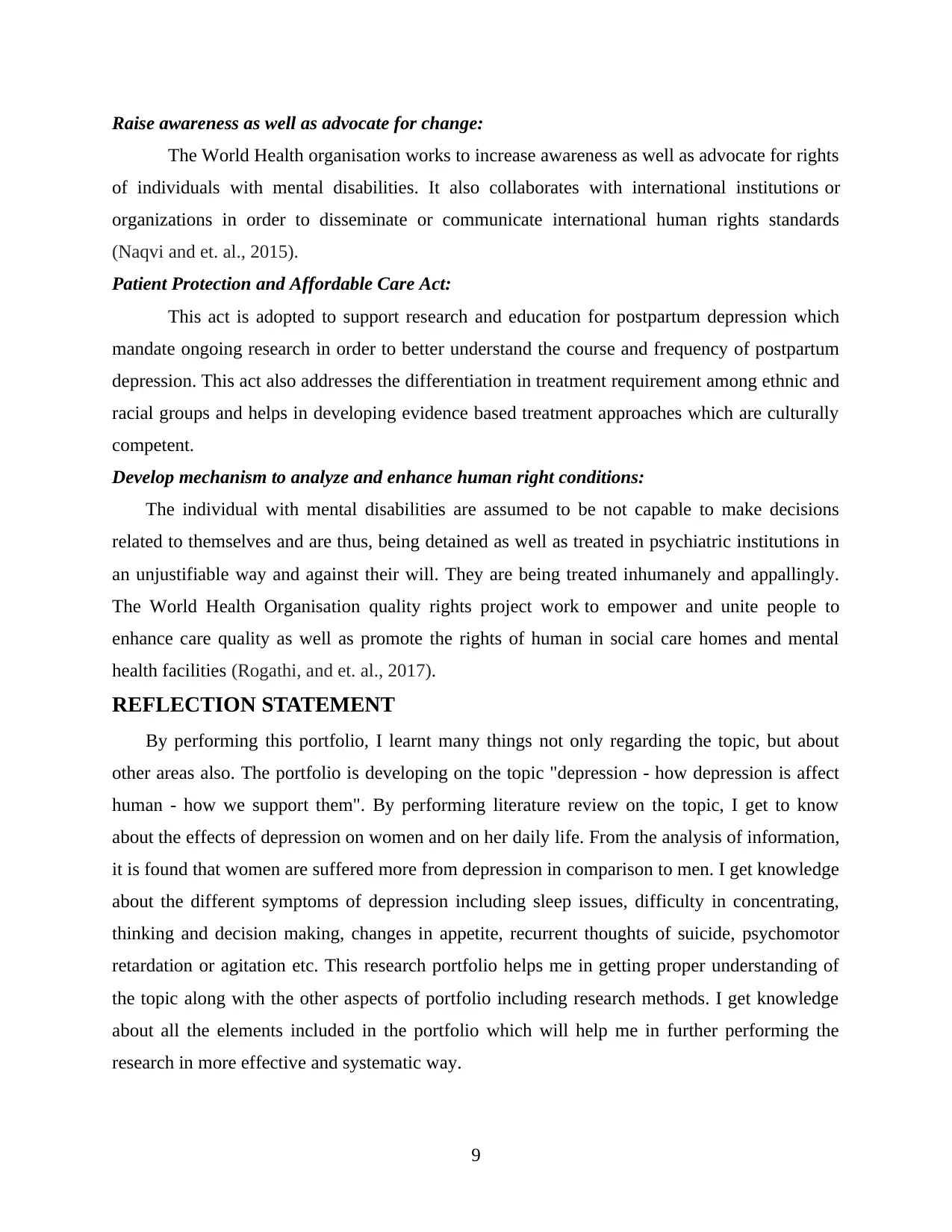
Raise awareness as well as advocate for change:
The World Health organisation works to increase awareness as well as advocate for rights
of individuals with mental disabilities. It also collaborates with international institutions or
organizations in order to disseminate or communicate international human rights standards
(Naqvi and et. al., 2015).
Patient Protection and Affordable Care Act:
This act is adopted to support research and education for postpartum depression which
mandate ongoing research in order to better understand the course and frequency of postpartum
depression. This act also addresses the differentiation in treatment requirement among ethnic and
racial groups and helps in developing evidence based treatment approaches which are culturally
competent.
Develop mechanism to analyze and enhance human right conditions:
The individual with mental disabilities are assumed to be not capable to make decisions
related to themselves and are thus, being detained as well as treated in psychiatric institutions in
an unjustifiable way and against their will. They are being treated inhumanely and appallingly.
The World Health Organisation quality rights project work to empower and unite people to
enhance care quality as well as promote the rights of human in social care homes and mental
health facilities (Rogathi, and et. al., 2017).
REFLECTION STATEMENT
By performing this portfolio, I learnt many things not only regarding the topic, but about
other areas also. The portfolio is developing on the topic "depression - how depression is affect
human - how we support them". By performing literature review on the topic, I get to know
about the effects of depression on women and on her daily life. From the analysis of information,
it is found that women are suffered more from depression in comparison to men. I get knowledge
about the different symptoms of depression including sleep issues, difficulty in concentrating,
thinking and decision making, changes in appetite, recurrent thoughts of suicide, psychomotor
retardation or agitation etc. This research portfolio helps me in getting proper understanding of
the topic along with the other aspects of portfolio including research methods. I get knowledge
about all the elements included in the portfolio which will help me in further performing the
research in more effective and systematic way.
9
The World Health organisation works to increase awareness as well as advocate for rights
of individuals with mental disabilities. It also collaborates with international institutions or
organizations in order to disseminate or communicate international human rights standards
(Naqvi and et. al., 2015).
Patient Protection and Affordable Care Act:
This act is adopted to support research and education for postpartum depression which
mandate ongoing research in order to better understand the course and frequency of postpartum
depression. This act also addresses the differentiation in treatment requirement among ethnic and
racial groups and helps in developing evidence based treatment approaches which are culturally
competent.
Develop mechanism to analyze and enhance human right conditions:
The individual with mental disabilities are assumed to be not capable to make decisions
related to themselves and are thus, being detained as well as treated in psychiatric institutions in
an unjustifiable way and against their will. They are being treated inhumanely and appallingly.
The World Health Organisation quality rights project work to empower and unite people to
enhance care quality as well as promote the rights of human in social care homes and mental
health facilities (Rogathi, and et. al., 2017).
REFLECTION STATEMENT
By performing this portfolio, I learnt many things not only regarding the topic, but about
other areas also. The portfolio is developing on the topic "depression - how depression is affect
human - how we support them". By performing literature review on the topic, I get to know
about the effects of depression on women and on her daily life. From the analysis of information,
it is found that women are suffered more from depression in comparison to men. I get knowledge
about the different symptoms of depression including sleep issues, difficulty in concentrating,
thinking and decision making, changes in appetite, recurrent thoughts of suicide, psychomotor
retardation or agitation etc. This research portfolio helps me in getting proper understanding of
the topic along with the other aspects of portfolio including research methods. I get knowledge
about all the elements included in the portfolio which will help me in further performing the
research in more effective and systematic way.
9
⊘ This is a preview!⊘
Do you want full access?
Subscribe today to unlock all pages.

Trusted by 1+ million students worldwide
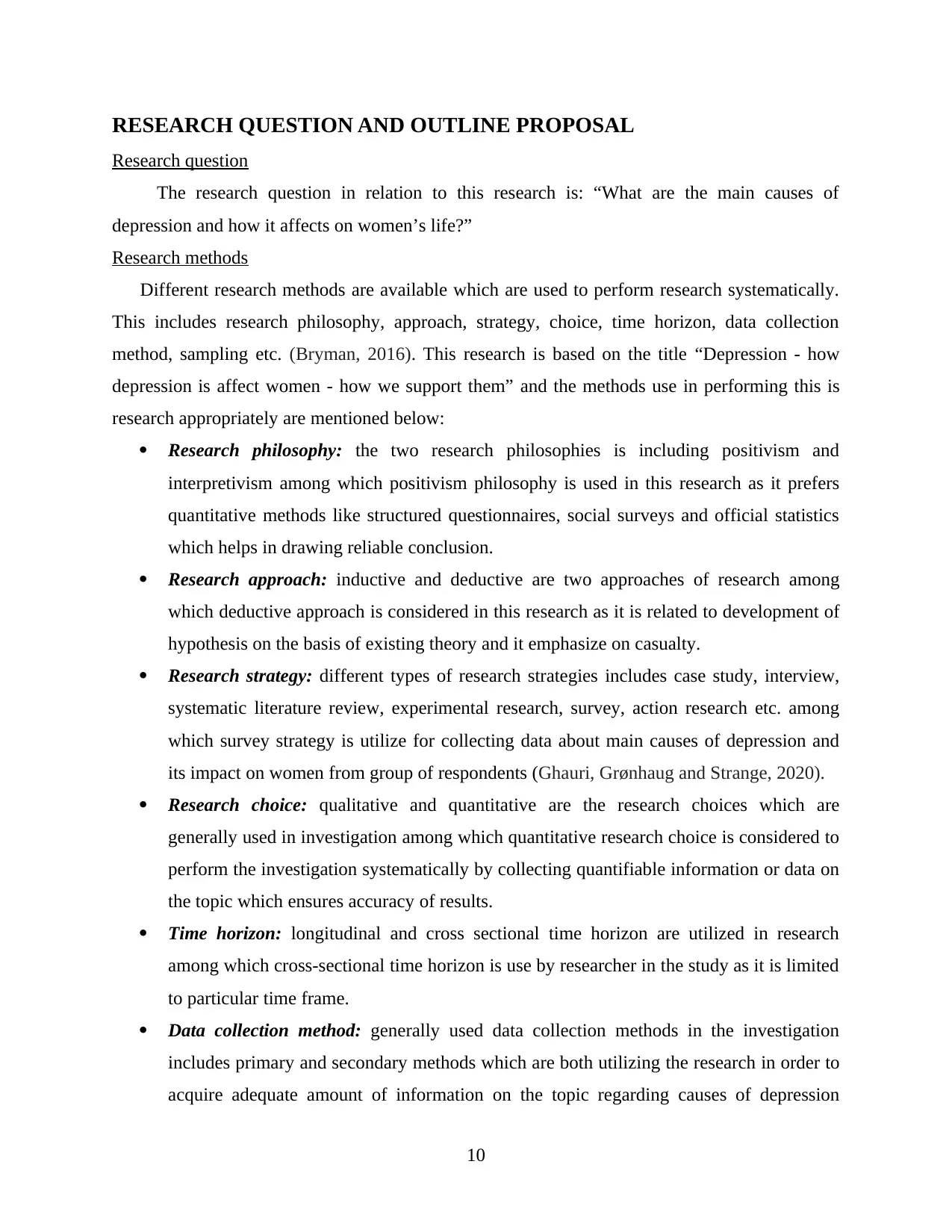
RESEARCH QUESTION AND OUTLINE PROPOSAL
Research question
The research question in relation to this research is: “What are the main causes of
depression and how it affects on women’s life?”
Research methods
Different research methods are available which are used to perform research systematically.
This includes research philosophy, approach, strategy, choice, time horizon, data collection
method, sampling etc. (Bryman, 2016). This research is based on the title “Depression - how
depression is affect women - how we support them” and the methods use in performing this is
research appropriately are mentioned below:
Research philosophy: the two research philosophies is including positivism and
interpretivism among which positivism philosophy is used in this research as it prefers
quantitative methods like structured questionnaires, social surveys and official statistics
which helps in drawing reliable conclusion.
Research approach: inductive and deductive are two approaches of research among
which deductive approach is considered in this research as it is related to development of
hypothesis on the basis of existing theory and it emphasize on casualty.
Research strategy: different types of research strategies includes case study, interview,
systematic literature review, experimental research, survey, action research etc. among
which survey strategy is utilize for collecting data about main causes of depression and
its impact on women from group of respondents (Ghauri, Grønhaug and Strange, 2020).
Research choice: qualitative and quantitative are the research choices which are
generally used in investigation among which quantitative research choice is considered to
perform the investigation systematically by collecting quantifiable information or data on
the topic which ensures accuracy of results.
Time horizon: longitudinal and cross sectional time horizon are utilized in research
among which cross-sectional time horizon is use by researcher in the study as it is limited
to particular time frame.
Data collection method: generally used data collection methods in the investigation
includes primary and secondary methods which are both utilizing the research in order to
acquire adequate amount of information on the topic regarding causes of depression
10
Research question
The research question in relation to this research is: “What are the main causes of
depression and how it affects on women’s life?”
Research methods
Different research methods are available which are used to perform research systematically.
This includes research philosophy, approach, strategy, choice, time horizon, data collection
method, sampling etc. (Bryman, 2016). This research is based on the title “Depression - how
depression is affect women - how we support them” and the methods use in performing this is
research appropriately are mentioned below:
Research philosophy: the two research philosophies is including positivism and
interpretivism among which positivism philosophy is used in this research as it prefers
quantitative methods like structured questionnaires, social surveys and official statistics
which helps in drawing reliable conclusion.
Research approach: inductive and deductive are two approaches of research among
which deductive approach is considered in this research as it is related to development of
hypothesis on the basis of existing theory and it emphasize on casualty.
Research strategy: different types of research strategies includes case study, interview,
systematic literature review, experimental research, survey, action research etc. among
which survey strategy is utilize for collecting data about main causes of depression and
its impact on women from group of respondents (Ghauri, Grønhaug and Strange, 2020).
Research choice: qualitative and quantitative are the research choices which are
generally used in investigation among which quantitative research choice is considered to
perform the investigation systematically by collecting quantifiable information or data on
the topic which ensures accuracy of results.
Time horizon: longitudinal and cross sectional time horizon are utilized in research
among which cross-sectional time horizon is use by researcher in the study as it is limited
to particular time frame.
Data collection method: generally used data collection methods in the investigation
includes primary and secondary methods which are both utilizing the research in order to
acquire adequate amount of information on the topic regarding causes of depression
10
Paraphrase This Document
Need a fresh take? Get an instant paraphrase of this document with our AI Paraphraser
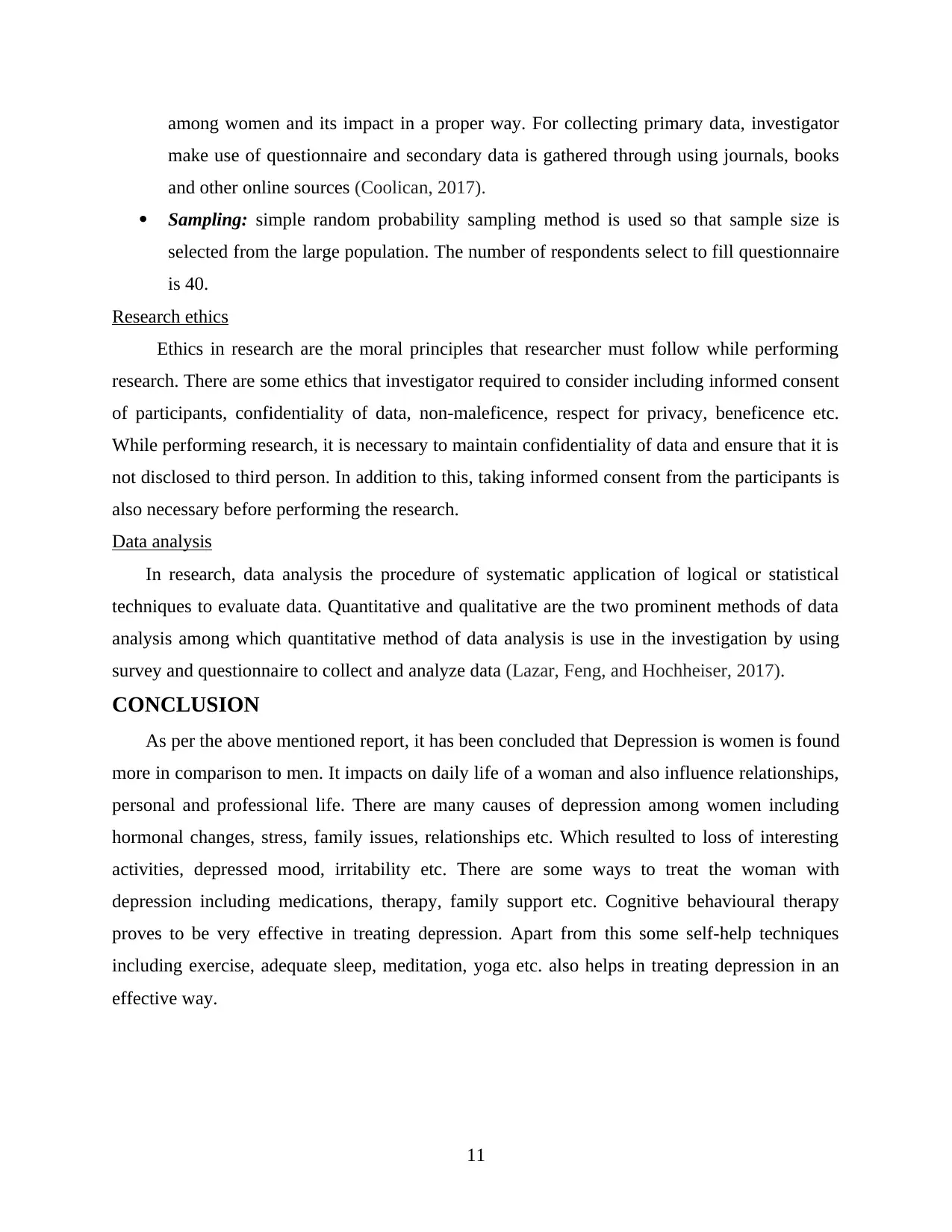
among women and its impact in a proper way. For collecting primary data, investigator
make use of questionnaire and secondary data is gathered through using journals, books
and other online sources (Coolican, 2017).
Sampling: simple random probability sampling method is used so that sample size is
selected from the large population. The number of respondents select to fill questionnaire
is 40.
Research ethics
Ethics in research are the moral principles that researcher must follow while performing
research. There are some ethics that investigator required to consider including informed consent
of participants, confidentiality of data, non-maleficence, respect for privacy, beneficence etc.
While performing research, it is necessary to maintain confidentiality of data and ensure that it is
not disclosed to third person. In addition to this, taking informed consent from the participants is
also necessary before performing the research.
Data analysis
In research, data analysis the procedure of systematic application of logical or statistical
techniques to evaluate data. Quantitative and qualitative are the two prominent methods of data
analysis among which quantitative method of data analysis is use in the investigation by using
survey and questionnaire to collect and analyze data (Lazar, Feng, and Hochheiser, 2017).
CONCLUSION
As per the above mentioned report, it has been concluded that Depression is women is found
more in comparison to men. It impacts on daily life of a woman and also influence relationships,
personal and professional life. There are many causes of depression among women including
hormonal changes, stress, family issues, relationships etc. Which resulted to loss of interesting
activities, depressed mood, irritability etc. There are some ways to treat the woman with
depression including medications, therapy, family support etc. Cognitive behavioural therapy
proves to be very effective in treating depression. Apart from this some self-help techniques
including exercise, adequate sleep, meditation, yoga etc. also helps in treating depression in an
effective way.
11
make use of questionnaire and secondary data is gathered through using journals, books
and other online sources (Coolican, 2017).
Sampling: simple random probability sampling method is used so that sample size is
selected from the large population. The number of respondents select to fill questionnaire
is 40.
Research ethics
Ethics in research are the moral principles that researcher must follow while performing
research. There are some ethics that investigator required to consider including informed consent
of participants, confidentiality of data, non-maleficence, respect for privacy, beneficence etc.
While performing research, it is necessary to maintain confidentiality of data and ensure that it is
not disclosed to third person. In addition to this, taking informed consent from the participants is
also necessary before performing the research.
Data analysis
In research, data analysis the procedure of systematic application of logical or statistical
techniques to evaluate data. Quantitative and qualitative are the two prominent methods of data
analysis among which quantitative method of data analysis is use in the investigation by using
survey and questionnaire to collect and analyze data (Lazar, Feng, and Hochheiser, 2017).
CONCLUSION
As per the above mentioned report, it has been concluded that Depression is women is found
more in comparison to men. It impacts on daily life of a woman and also influence relationships,
personal and professional life. There are many causes of depression among women including
hormonal changes, stress, family issues, relationships etc. Which resulted to loss of interesting
activities, depressed mood, irritability etc. There are some ways to treat the woman with
depression including medications, therapy, family support etc. Cognitive behavioural therapy
proves to be very effective in treating depression. Apart from this some self-help techniques
including exercise, adequate sleep, meditation, yoga etc. also helps in treating depression in an
effective way.
11
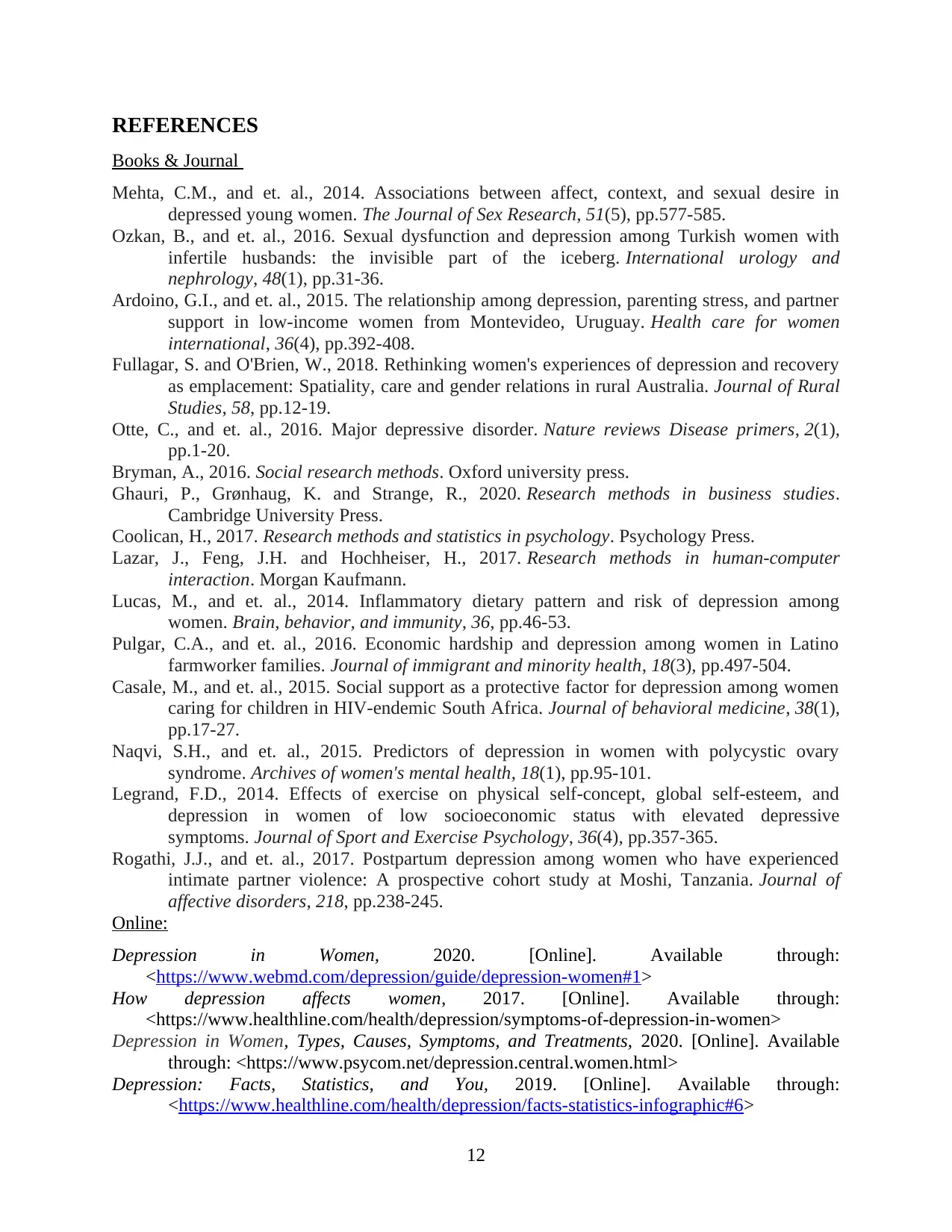
REFERENCES
Books & Journal
Mehta, C.M., and et. al., 2014. Associations between affect, context, and sexual desire in
depressed young women. The Journal of Sex Research, 51(5), pp.577-585.
Ozkan, B., and et. al., 2016. Sexual dysfunction and depression among Turkish women with
infertile husbands: the invisible part of the iceberg. International urology and
nephrology, 48(1), pp.31-36.
Ardoino, G.I., and et. al., 2015. The relationship among depression, parenting stress, and partner
support in low-income women from Montevideo, Uruguay. Health care for women
international, 36(4), pp.392-408.
Fullagar, S. and O'Brien, W., 2018. Rethinking women's experiences of depression and recovery
as emplacement: Spatiality, care and gender relations in rural Australia. Journal of Rural
Studies, 58, pp.12-19.
Otte, C., and et. al., 2016. Major depressive disorder. Nature reviews Disease primers, 2(1),
pp.1-20.
Bryman, A., 2016. Social research methods. Oxford university press.
Ghauri, P., Grønhaug, K. and Strange, R., 2020. Research methods in business studies.
Cambridge University Press.
Coolican, H., 2017. Research methods and statistics in psychology. Psychology Press.
Lazar, J., Feng, J.H. and Hochheiser, H., 2017. Research methods in human-computer
interaction. Morgan Kaufmann.
Lucas, M., and et. al., 2014. Inflammatory dietary pattern and risk of depression among
women. Brain, behavior, and immunity, 36, pp.46-53.
Pulgar, C.A., and et. al., 2016. Economic hardship and depression among women in Latino
farmworker families. Journal of immigrant and minority health, 18(3), pp.497-504.
Casale, M., and et. al., 2015. Social support as a protective factor for depression among women
caring for children in HIV-endemic South Africa. Journal of behavioral medicine, 38(1),
pp.17-27.
Naqvi, S.H., and et. al., 2015. Predictors of depression in women with polycystic ovary
syndrome. Archives of women's mental health, 18(1), pp.95-101.
Legrand, F.D., 2014. Effects of exercise on physical self-concept, global self-esteem, and
depression in women of low socioeconomic status with elevated depressive
symptoms. Journal of Sport and Exercise Psychology, 36(4), pp.357-365.
Rogathi, J.J., and et. al., 2017. Postpartum depression among women who have experienced
intimate partner violence: A prospective cohort study at Moshi, Tanzania. Journal of
affective disorders, 218, pp.238-245.
Online:
Depression in Women, 2020. [Online]. Available through:
<https://www.webmd.com/depression/guide/depression-women#1>
How depression affects women, 2017. [Online]. Available through:
<https://www.healthline.com/health/depression/symptoms-of-depression-in-women>
Depression in Women, Types, Causes, Symptoms, and Treatments, 2020. [Online]. Available
through: <https://www.psycom.net/depression.central.women.html>
Depression: Facts, Statistics, and You, 2019. [Online]. Available through:
<https://www.healthline.com/health/depression/facts-statistics-infographic#6>
12
Books & Journal
Mehta, C.M., and et. al., 2014. Associations between affect, context, and sexual desire in
depressed young women. The Journal of Sex Research, 51(5), pp.577-585.
Ozkan, B., and et. al., 2016. Sexual dysfunction and depression among Turkish women with
infertile husbands: the invisible part of the iceberg. International urology and
nephrology, 48(1), pp.31-36.
Ardoino, G.I., and et. al., 2015. The relationship among depression, parenting stress, and partner
support in low-income women from Montevideo, Uruguay. Health care for women
international, 36(4), pp.392-408.
Fullagar, S. and O'Brien, W., 2018. Rethinking women's experiences of depression and recovery
as emplacement: Spatiality, care and gender relations in rural Australia. Journal of Rural
Studies, 58, pp.12-19.
Otte, C., and et. al., 2016. Major depressive disorder. Nature reviews Disease primers, 2(1),
pp.1-20.
Bryman, A., 2016. Social research methods. Oxford university press.
Ghauri, P., Grønhaug, K. and Strange, R., 2020. Research methods in business studies.
Cambridge University Press.
Coolican, H., 2017. Research methods and statistics in psychology. Psychology Press.
Lazar, J., Feng, J.H. and Hochheiser, H., 2017. Research methods in human-computer
interaction. Morgan Kaufmann.
Lucas, M., and et. al., 2014. Inflammatory dietary pattern and risk of depression among
women. Brain, behavior, and immunity, 36, pp.46-53.
Pulgar, C.A., and et. al., 2016. Economic hardship and depression among women in Latino
farmworker families. Journal of immigrant and minority health, 18(3), pp.497-504.
Casale, M., and et. al., 2015. Social support as a protective factor for depression among women
caring for children in HIV-endemic South Africa. Journal of behavioral medicine, 38(1),
pp.17-27.
Naqvi, S.H., and et. al., 2015. Predictors of depression in women with polycystic ovary
syndrome. Archives of women's mental health, 18(1), pp.95-101.
Legrand, F.D., 2014. Effects of exercise on physical self-concept, global self-esteem, and
depression in women of low socioeconomic status with elevated depressive
symptoms. Journal of Sport and Exercise Psychology, 36(4), pp.357-365.
Rogathi, J.J., and et. al., 2017. Postpartum depression among women who have experienced
intimate partner violence: A prospective cohort study at Moshi, Tanzania. Journal of
affective disorders, 218, pp.238-245.
Online:
Depression in Women, 2020. [Online]. Available through:
<https://www.webmd.com/depression/guide/depression-women#1>
How depression affects women, 2017. [Online]. Available through:
<https://www.healthline.com/health/depression/symptoms-of-depression-in-women>
Depression in Women, Types, Causes, Symptoms, and Treatments, 2020. [Online]. Available
through: <https://www.psycom.net/depression.central.women.html>
Depression: Facts, Statistics, and You, 2019. [Online]. Available through:
<https://www.healthline.com/health/depression/facts-statistics-infographic#6>
12
⊘ This is a preview!⊘
Do you want full access?
Subscribe today to unlock all pages.

Trusted by 1+ million students worldwide
1 out of 13
Related Documents
Your All-in-One AI-Powered Toolkit for Academic Success.
+13062052269
info@desklib.com
Available 24*7 on WhatsApp / Email
![[object Object]](/_next/static/media/star-bottom.7253800d.svg)
Unlock your academic potential
Copyright © 2020–2025 A2Z Services. All Rights Reserved. Developed and managed by ZUCOL.





